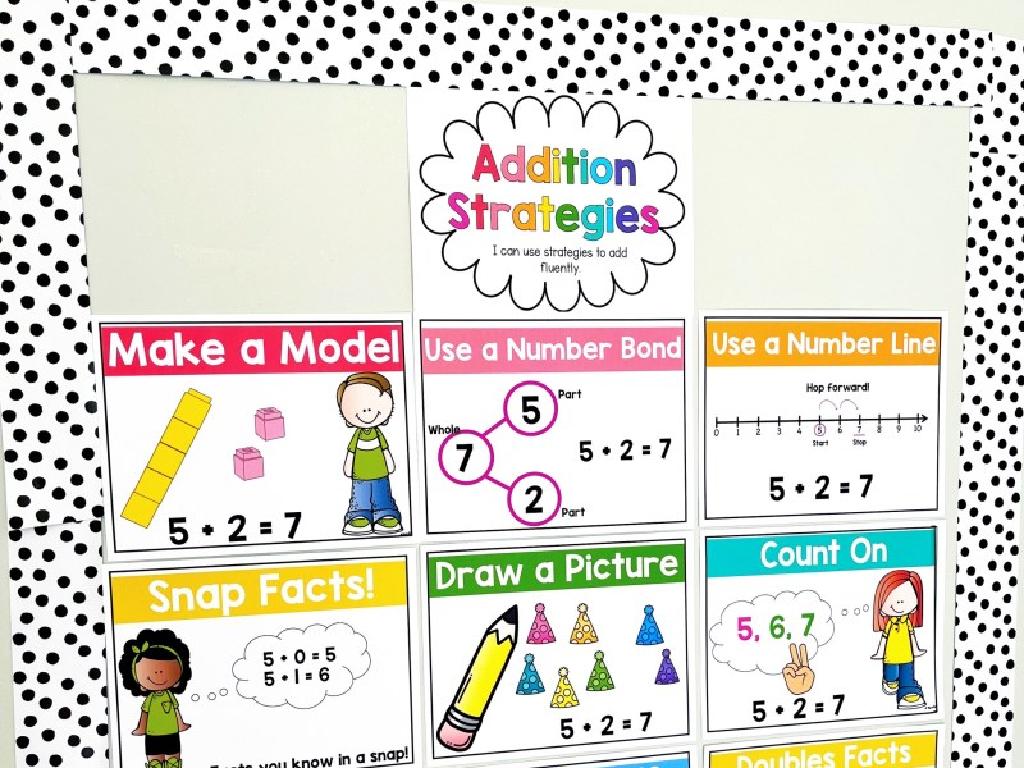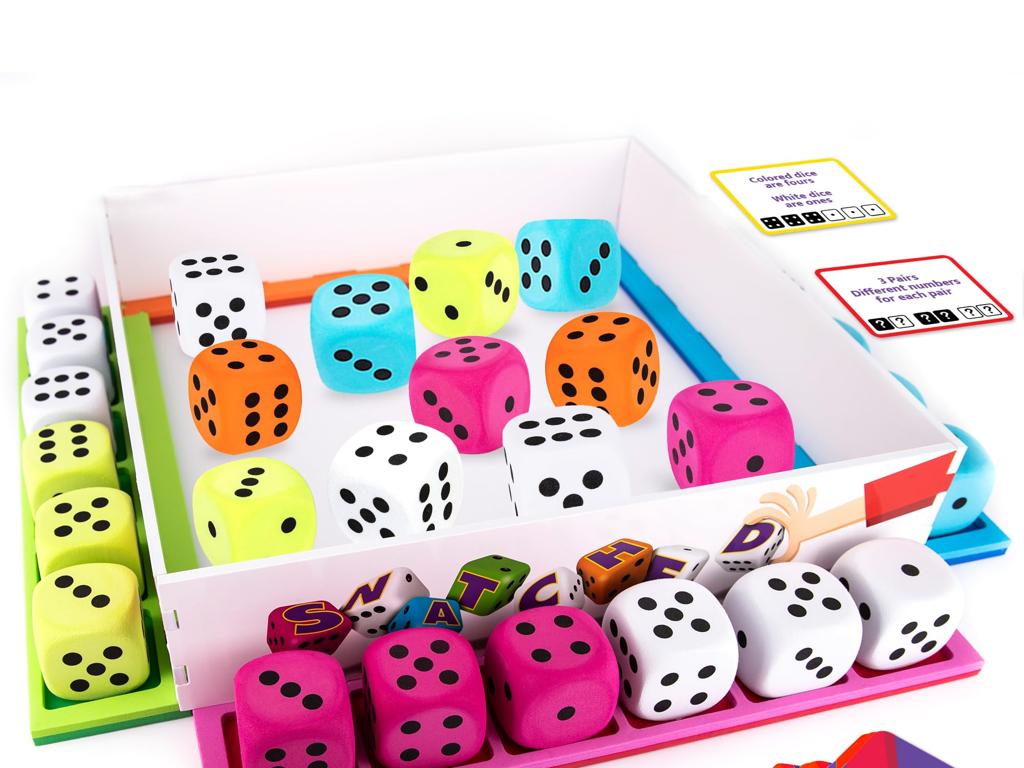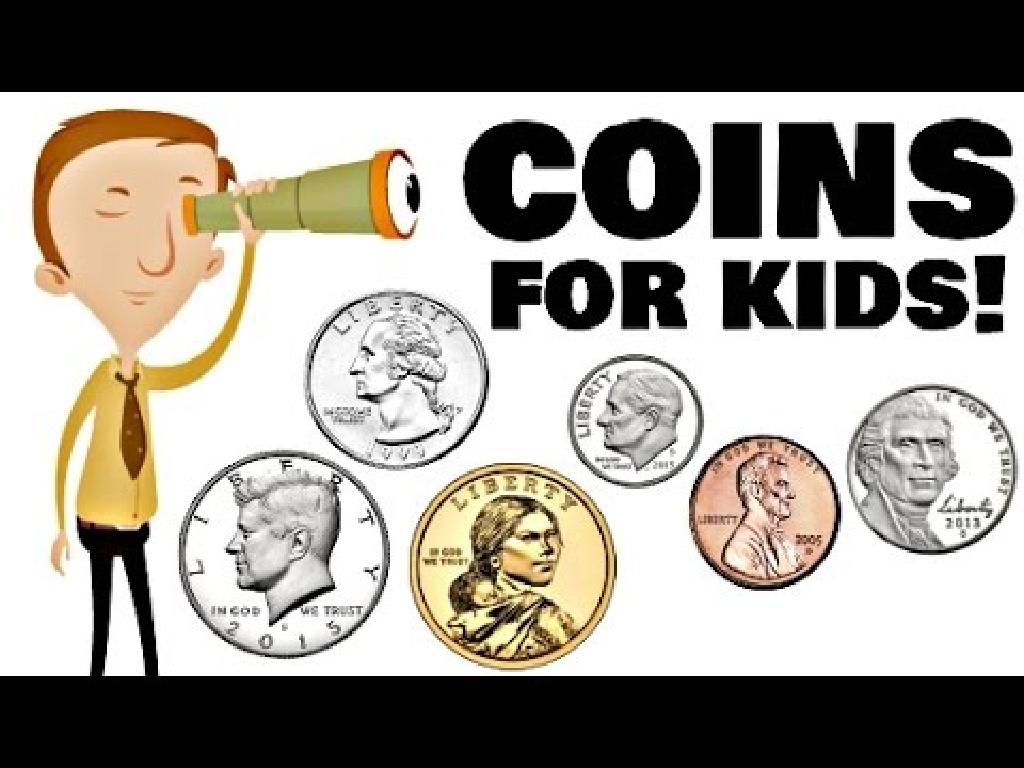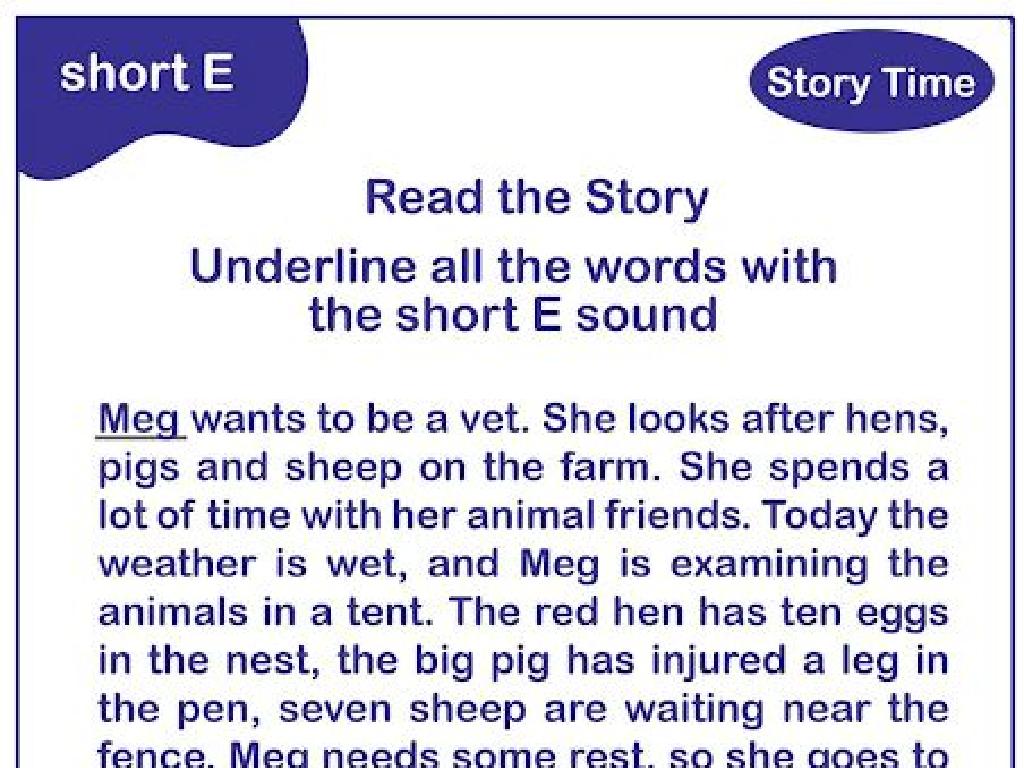Read Along With Realistic Fiction
Subject: Language arts
Grade: Kindergarten
Topic: Read-Along Literary Texts
Please LOG IN to download the presentation. Access is available to registered users only.
View More Content
Welcome to Read-Along: Exploring Realistic Fiction
– Today’s fun story read-along
– Understanding realistic fiction
– Stories that seem real but are made up
– Stories that mimic real life
– Like losing a tooth or going to school
– Engage with the story
– Listen and imagine you’re in the story!
|
This slide introduces kindergarteners to the concept of realistic fiction in an engaging read-along session. Realistic fiction is a genre that includes stories that could actually happen in real life, which helps children connect with the characters and situations. Use examples that are relatable to their daily experiences, such as making a new friend or visiting the park. Encourage the children to listen carefully and use their imagination to picture themselves within the story. This activity aims to foster a love for reading and help students understand the difference between fictional stories and real-life events.
Meet the Characters in Our Story
– Characters seem like real people
– They have names and feelings
– Think about how you feel when happy or sad
– Characters experience adventures
– Like going to the park or having a birthday party
– Let’s get to know our story’s characters
– We will learn who they are and what they do
|
This slide introduces the concept of characters in realistic fiction to Kindergarten students. Emphasize that characters in these stories are similar to people they might know in real life, with their own names, emotions, and experiences. Encourage the children to relate to the characters by comparing their feelings and adventures to their own. As you read the story, point out the characters’ actions and emotions, and ask the students to share their thoughts about what the characters might do next. This will help them engage with the story and develop empathy and understanding of the characters.
Setting the Scene in Our Story
– Understanding ‘setting’
– ‘Setting’ means where the story happens.
– Our story’s familiar places
– Think of places like your home, school, or park.
– Guess the story’s setting
– Can you imagine where our characters are?
– Discuss settings we know
– Let’s talk about places we visit every day.
|
This slide introduces the concept of ‘setting’ in a story to Kindergarten students. It’s important to use relatable examples to explain that the setting is where the story takes place. Encourage the children to think of places they are familiar with, such as their own home, school, or local park. Ask them to guess the setting of the story you will read. This interactive approach will help them connect with the concept of setting and make them more engaged in the storytelling process. Prepare to guide a discussion about different settings and how they might look or feel, enhancing their connection to the story and broadening their understanding of different environments.
Listening and Predicting with Realistic Fiction
– Listen carefully as I read
– Think about the story’s next steps
– What do you think will happen after this?
– Let’s predict the story together
– We’ll guess what comes next in the story
– Share your predictions with the class
– Tell us what you think might happen
|
This slide is designed to engage Kindergarten students in active listening and prediction skills during a read-along session. As the teacher reads a realistic fiction book, prompt students to listen attentively and think ahead about the plot. Encourage them to use their imagination and clues from the story to make predictions about what might happen next. After reading a section, pause to discuss their ideas as a group, fostering a collaborative learning environment. This activity helps develop critical thinking, comprehension, and verbal expression. Tailor the discussion to ensure it’s accessible and enjoyable for young learners, using simple language and relatable examples.
Read-Along Time with Realistic Fiction
– Listen as I read the story
– Observe the pictures closely
– Pictures can tell us more about the story
– Questions are welcome anytime
– If something confuses you, just ask!
– Enjoy the story together
|
This slide is for a read-along activity designed for kindergarten students to engage with realistic fiction. As the teacher reads the story aloud, students should be encouraged to follow along and pay attention to the illustrations, which will enhance their understanding of the narrative. It’s important to create an interactive environment where students feel comfortable to inquire about any aspect of the story that piques their curiosity. This activity will help develop their listening skills, comprehension, and ability to connect images with text. The teacher should pause at intervals to discuss the plot and answer questions, ensuring that the students are comprehending and enjoying the story.
Discussing Our Story
– Share what you liked
– How characters solved problems
– Characters may use teamwork or creativity
– Relate to your own experiences
– Think of a time you faced a challenge
– Group discussion and sharing
|
This slide is meant to facilitate a discussion among the kindergarten students about the realistic fiction story they read along with. Start by asking the students what parts of the story they enjoyed the most and why. Then, move on to discuss the problem-solving strategies used by the characters, highlighting the importance of teamwork or creative thinking. Encourage the children to draw parallels between the characters’ experiences and their own lives, which helps them connect with the story on a personal level. Finally, create a supportive environment for group discussion where each child can share their thoughts and listen to others, fostering social and emotional development along with literacy skills.
Our Own Stories: Creating and Sharing
– Create your short story
– Base it on a real event
– Think of something fun or interesting that really happened.
– Draw a picture of the story
– Your drawing shows what the story looks like.
– Share with the class
|
This activity is designed to engage students with realistic fiction by encouraging them to draw from their own experiences. Guide them to think of a simple, real-life event that they found exciting, funny, or memorable. Provide them with drawing materials and help them as they illustrate their story. Once everyone is ready, create a comfortable sharing environment where each student can present their story and artwork to the class. This will help them understand the concept of realistic fiction and improve their storytelling and presentation skills. Offer positive feedback and facilitate a discussion about the events in their stories to enhance their engagement.
Class Activity: Story Circle Time
– Sit together in a story circle
– Take turns telling stories
– Each child will share their own tale
– Use pictures for storytelling
– Show and tell with your favorite drawing
– Listen carefully to friends
– It’s important to be a good listener
|
This activity is designed to foster creativity and listening skills among the students. Arrange the classroom seating into a large circle. Each student will have a turn to stand up and tell a story, using a picture they have drawn or chosen as a visual aid to enhance their storytelling. Encourage them to think about the beginning, middle, and end of their stories. Remind the children about the importance of listening and showing respect while others are speaking. For the teacher: have a set of diverse and engaging pictures ready for children who might not have one. Prepare to guide the children through their storytelling by asking prompting questions if they get stuck. Consider recording the stories so children can hear the playback and reflect on their storytelling skills.
Celebrating Our Story Journey
– Proud of our reading today
– Realistic fiction teaches us
– Stories that could really happen
– Keep imagining new stories
– Use your imagination to make up tales
– Share your stories with others
– Tell your stories to friends and family
|
Today’s class was a success, and the students did a fantastic job reading and creating their own realistic fiction stories. It’s important to reinforce the value of realistic fiction in helping children understand the world around them. Encourage them to continue using their imagination to craft stories and to share these stories with others, which will help develop their narrative skills and boost their confidence. Remember to praise their efforts and creativity, and suggest that they keep a journal of their stories to see how their writing evolves over time.






